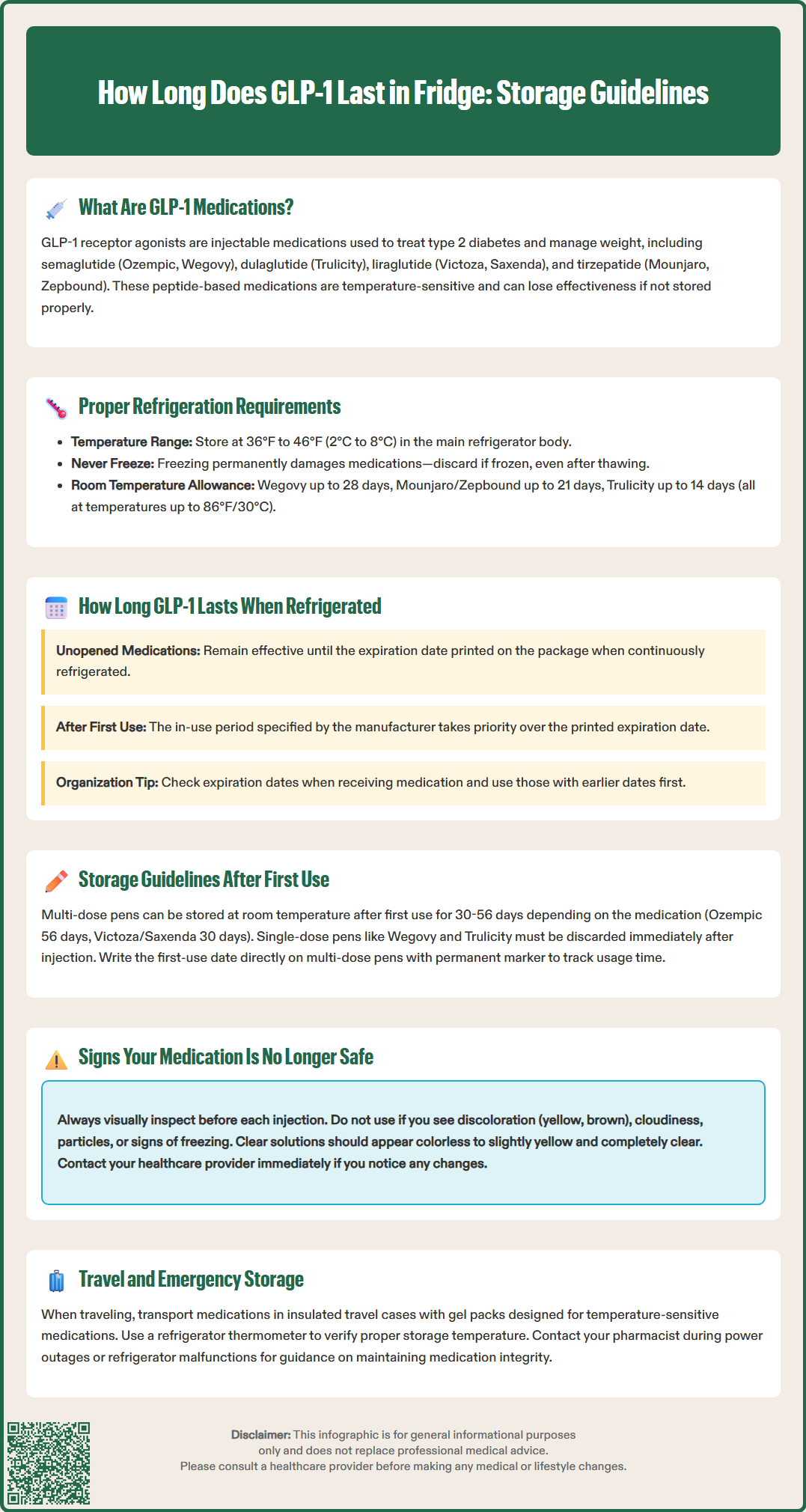LOSE WEIGHT WITH MEDICAL SUPPORT — BUILT FOR MEN
- Your personalised programme is built around medical care, not willpower.
- No generic diets. No guesswork.
- Just science-backed results and expert support.
Find out if you’re eligible

How long does GLP-1 last in fridge? Unopened GLP-1 medications stored properly in the refrigerator at 36°F to 46°F (2°C to 8°C) remain effective until the expiration date printed on the packaging. These temperature-sensitive peptide medications—including semaglutide (Ozempic, Wegovy), dulaglutide (Trulicity), liraglutide (Victoza, Saxenda), and tirzepatide (Mounjaro, Zepbound)—require specific storage conditions to maintain therapeutic effectiveness. Understanding proper refrigeration requirements, in-use storage periods, and signs of medication degradation is essential for patients managing type 2 diabetes or chronic weight, ensuring optimal treatment outcomes and preventing costly medication waste.
Quick Answer: Unopened GLP-1 medications stored properly in the refrigerator at 36°F to 46°F remain effective until the manufacturer's expiration date printed on the packaging.
We offer compounded medications and Zepbound®. Compounded medications are prepared by licensed pharmacies and are not FDA-approved. References to Wegovy®, Ozempic®, Rybelsus®, Mounjaro®, or Saxenda®, or other GLP-1 brands, are informational only. Compounded and FDA-approved medications are not interchangeable.
Glucagon-like peptide-1 (GLP-1) receptor agonists are a class of injectable medications primarily used to manage type 2 diabetes mellitus and, in some formulations, chronic weight management. These medications include semaglutide (Ozempic, Wegovy), dulaglutide (Trulicity), liraglutide (Victoza, Saxenda), exenatide (Byetta, Bydureon BCise), and tirzepatide (Mounjaro, Zepbound)—though tirzepatide is technically a dual GIP/GLP-1 receptor agonist.
These medications work by mimicking the action of naturally occurring incretin hormones that the body produces in response to food intake. The primary mechanisms of action include:
Enhancing glucose-dependent insulin secretion from pancreatic beta cells, which helps lower blood glucose levels when they are elevated
Suppressing glucagon release from pancreatic alpha cells, reducing hepatic glucose production
Slowing gastric emptying, which moderates the rate at which nutrients enter the bloodstream
Promoting satiety through central nervous system pathways, leading to reduced caloric intake
These medications are peptide-based (and one fusion protein) and are temperature sensitive. Unlike many oral medications that remain stable at room temperature, GLP-1 receptor agonists require specific storage conditions to maintain their therapeutic effectiveness. The peptide structure can degrade when exposed to inappropriate storage conditions, potentially affecting medication efficacy.
Understanding proper storage requirements is essential for patients using these medications, as improper handling can compromise treatment outcomes and represent a significant financial loss given the cost of these therapies. Proper medication storage is an important component of diabetes self-management, and patients should always follow the specific storage instructions in their medication's FDA-approved prescribing information.
Most GLP-1 medications require refrigeration before first use at temperatures between 36°F and 46°F (2°C to 8°C). However, many products allow limited room-temperature storage periods according to their FDA-approved prescribing information.
Key refrigeration guidelines include:
Store in the main body of the refrigerator, not in the door where temperature fluctuations are more common due to frequent opening and closing
Keep away from the freezer compartment to prevent accidental freezing, which permanently damages the medication
Never freeze GLP-1 medications—frozen medication must be discarded even if subsequently thawed
Protect from light by keeping medications in their original carton until ready for use
Avoid storing near cooling elements or at the back of the refrigerator where temperatures may drop below the recommended range
Do not store pens with needles attached
Many GLP-1 medications can be stored at room temperature for limited periods before use:
Wegovy (semaglutide): May be stored at room temperature (up to 86°F/30°C) for up to 28 days before use
Trulicity (dulaglutide): May be stored at room temperature (up to 86°F/30°C) for up to 14 days before use
Mounjaro/Zepbound (tirzepatide): May be stored at room temperature (up to 86°F/30°C) for up to 21 days before use
Bydureon BCise (exenatide ER): May be stored at room temperature for up to 4 weeks before use (per prescribing information)
Patients should verify their refrigerator maintains appropriate temperatures using a refrigerator thermometer. During power outages or refrigerator malfunctions, patients should contact their pharmacist or the medication manufacturer for guidance on temperature excursions.
When traveling, patients should use insulated medication travel cases with gel packs specifically designed for temperature-sensitive medications. Always consult the FDA-approved prescribing information for your specific GLP-1 medication, as storage requirements vary between products.

Unopened GLP-1 medications stored properly in the refrigerator remain effective until the expiration date printed on the packaging, which is typically determined by the manufacturer for each specific lot. This expiration date applies when the medication has been continuously refrigerated at the appropriate temperature range and has never been frozen.
The shelf life varies by specific product, and all medications should be used before the expiration date printed on the packaging when stored according to the manufacturer's instructions:
Semaglutide (Ozempic, Wegovy): Unopened pens may be stored in the refrigerator until the expiration date on the label
Dulaglutide (Trulicity): Remains stable when refrigerated until the printed expiration date
Liraglutide (Victoza, Saxenda): Maintains potency when refrigerated continuously until expiration
Tirzepatide (Mounjaro, Zepbound): Stable under refrigeration until the manufacturer's expiration date
Exenatide (Byetta, Bydureon BCise): Requires refrigeration and remains effective until expiration when stored properly
It is important to note that permitted room-temperature storage periods as specified in the prescribing information do not invalidate the expiration date. However, once a multi-dose pen is first used, the in-use period (discussed in the next section) takes precedence over the printed expiration date.
Patients should inspect the expiration date upon receiving their medication from the pharmacy and organize their refrigerator storage to use medications with earlier expiration dates first. Pharmacies are responsible for ensuring medications are stored appropriately before dispensing, but patients should verify the expiration date is adequate for their dosing schedule. If a medication is approaching expiration and will not be used in time, patients should contact their pharmacy or healthcare provider rather than using expired medication.
Storage guidelines differ between multi-dose pens and single-dose devices, and it's important to understand which type of device you're using.
Multi-dose pens (used for multiple injections) have specific in-use storage periods after first use:
Semaglutide (Ozempic): After first use, may be stored in the refrigerator or at room temperature (up to 86°F/30°C) for up to 56 days
Liraglutide (Victoza): After first use, can be stored refrigerated or at room temperature (59-86°F/15-30°C) for 30 days
Liraglutide (Saxenda): After first use, can be stored refrigerated or at room temperature (59-86°F/15-30°C) for 30 days
Exenatide (Byetta): After first use, store at room temperature (68-77°F/20-25°C) for up to 30 days; do not refrigerate; protect from light
Single-dose devices (used once and discarded) have no "after first use" storage period because they should be discarded immediately after injection:
Semaglutide (Wegovy): Single-dose pen; discard after injection. Before use, may be stored at room temperature (up to 86°F/30°C) for up to 28 days
Dulaglutide (Trulicity): Single-dose pen; discard after injection. Before use, may be stored at room temperature (up to 86°F/30°C) for up to 14 days
Tirzepatide (Mounjaro, Zepbound): Single-dose pen; discard after injection. Before use, may be stored at room temperature (up to 86°F/30°C) for up to 21 days
Exenatide extended-release (Bydureon BCise): Single-dose autoinjector; discard after injection. Before use, may be stored at room temperature for up to 4 weeks per prescribing information
For multi-dose pens, patients should write the date of first use directly on the pen using a permanent marker to track how long the medication has been in use. This practice is essential because the in-use time limit takes precedence over the printed expiration date.
Many patients find it more convenient to store in-use pens at room temperature, which can reduce injection site discomfort associated with cold medication. However, room temperature storage must not exceed the specified temperature limits, and medications should never be exposed to direct sunlight or heat sources such as windowsills, car interiors, or near appliances. Always follow the specific storage instructions in your medication's FDA-approved prescribing information.
Visual inspection before each injection is a critical safety practice for all GLP-1 medication users. Changes in the medication's appearance may indicate degradation, contamination, or improper storage that renders the medication unsafe or ineffective.
Patients should not use the medication and should contact their healthcare provider or pharmacist if they observe any of the following:
For clear solution products (Ozempic, Wegovy, Trulicity, Victoza, Saxenda, Mounjaro, Zepbound, Byetta):
Discoloration: The solution appears yellow (beyond slight yellowish tint allowed in some products), brown, or any color other than clear and colorless to slightly yellow (per product-specific labeling)
Cloudiness or turbidity: The medication appears hazy, milky, or cloudy rather than clear
Visible particles: Any floating particles, crystals, flakes, or sediment are present in the solution
For Bydureon BCise (exenatide extended-release):
The suspension should be white to off-white and cloudy after mixing
Do not use if you see clumps or particles after mixing
For all products:
Frosting or ice crystals: Evidence that the medication has been frozen, even if subsequently thawed
Damaged pen or cartridge: Cracks, leaks, or other physical damage to the delivery device
Additional circumstances requiring medication disposal include:
Exceeded in-use time limits: For multi-dose pens, the medication has been in use longer than the manufacturer's specified period after first use
Past expiration date: The printed expiration date has passed
Unknown storage history: Uncertainty about whether the medication was properly stored or exposed to temperature extremes
Suspected freezing: The medication may have been exposed to freezing temperatures during storage or transport
Patients experiencing unexpected hyperglycemia or reduced therapeutic effect should consider the possibility of degraded medication, particularly if storage conditions may have been compromised. However, reduced effectiveness can have multiple causes, and patients should consult their healthcare provider rather than simply replacing the medication.
Proper disposal of unusable GLP-1 medications is important for safety and environmental protection. Used or expired pens should be disposed of according to local regulations for sharps and pharmaceutical waste. Many communities offer medication take-back programs, and the FDA provides guidance on safe home disposal when take-back options are unavailable. Patients should never share GLP-1 pens with others, even if the needle is changed, due to the risk of bloodborne pathogen transmission.
No, GLP-1 medications that have been frozen must be discarded even if subsequently thawed, as freezing permanently damages the peptide structure and compromises medication effectiveness.
Yes, multi-dose pens like Ozempic and Victoza have specific in-use storage periods after first use (up to 56 days and 30 days respectively), while single-dose devices like Wegovy, Trulicity, and Mounjaro are discarded immediately after injection.
Store GLP-1 medications in the main body of the refrigerator, not in the door where temperature fluctuations occur, and keep them away from the freezer compartment to prevent accidental freezing.
All medical content on this blog is created using reputable, evidence-based sources and is regularly reviewed for accuracy and relevance. While we strive to keep our content current with the latest research and clinical guidelines, it is intended for general informational purposes only.
This content is not a substitute for professional medical advice, diagnosis, or treatment. Always consult a licensed healthcare provider with any medical questions or concerns. Use of this information is at your own risk, and we are not liable for any outcomes resulting from its use.